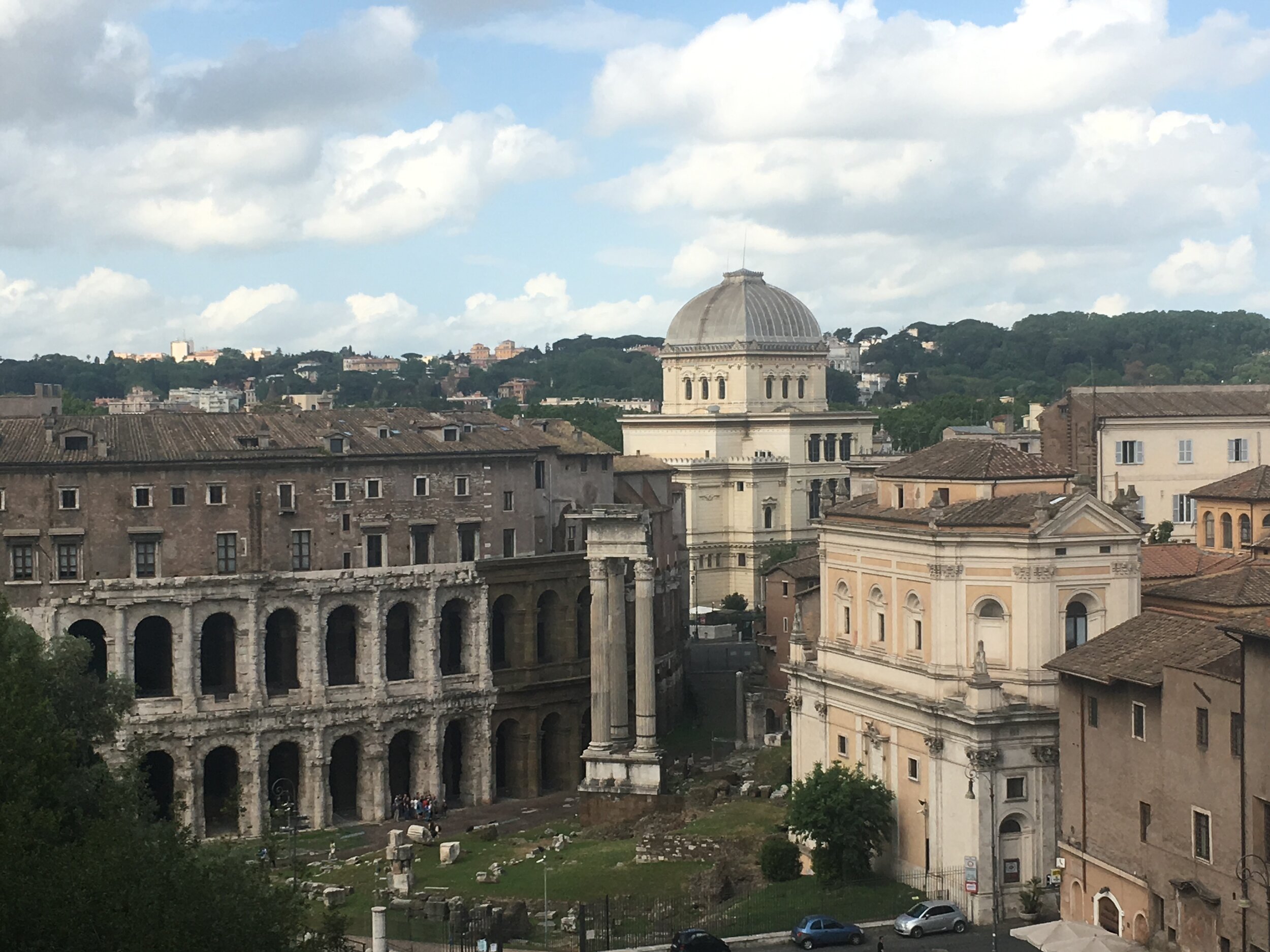Spot in Rome-Portico D’Ottavia
I chose this ‘spot’ as one of my 10 to highlight because it is aesthetically striking and still sometimes overlooked. It is located in one of the most evocative areas of Rome, weighted with history, tragedy and resilience. Often referred to as the ‘Ghetto’, and you will even see this on most maps; I will use the ‘Jewish Quarter’ or ‘Ex-Ghetto’ when referencing the area throughout my website. Pam, one of my best friends, (and an amazing social justice lawyer to boot), in fact, used the phrase Jewish quarter when visiting me many years ago; she did not ‘correct’ me for saying ‘Ghetto’ just opted for this signifier, and since that moment, I have done the same.
The Jewish quarter of Rome is home to this ancient Portico in addition to a number of excellent restaurants and bars. I encourage you to explore the area before and after admiring the Portico D’Ottavia. Like most monuments in Rome, this one has a layered history. A portico (or ‘porch’ for a loose translation; read more here regarding the architectural meaning) was built by a wealthy Roman conqueror named Cecilius Metellus in the 2nd century BCE. It was more famously rebuilt by the Emperor Augustus sometime after he came to power as Rome’s first (official) emperor in 27 BCE, after the death of his great uncle Julius Caesar. Augustus dedicated the structure to his sister, Octavia Minor, hence the name it bears today. This ancient portico once contained two temples (dedicated to Jupiter Stator and Juno Regina) and Octavia herself built a library within the complex. Here is an image of a reconstruction with the two temples inside.
In the medieval period the structure took on a different purpose and was used as a fish market; it had this function through the end of the 19th century. In fact, when you walk up under the portico, which you can and should do, you will notice the façade of what looks like a church. It is, in fact, a church named Sant'Angelo in Pescheria that was built in the 8th century CE. ‘In Pescheria’ translates to ‘in the fish market’ because of its location. Thus, this ‘spot’ has eclectic elements built into its own unique palimpsest, in the context of the larger palimpsest of Rome.
The dark history of the area is related to the persecution of the Jewish people, particularly during the Nazi occupation, but not only. In the mid 16th century, Pope Paul IV forced the Jewish population of Rome to move into this area. As mentioned in the entry on Santa Maria in Trastevere, the first synagogue was built across the river on the quiet side of Trastevere, where Jews also lived and thrived for centuries. This containment came with other sorrows, as explained by Lucentini in The Rome Guide. For example, Popes had started to require Jews to wear distinctive clothing from the late middle ages and also forced them to participate in Carnival activities only to embarrass and abuse them. This ‘overview’ is reductive and superficial, but it offers a starting place, leading to the 20th century history.
In 1943, Rome was occupied by the Nazis. This happened after the Allies bombed the area of San Lorenzo in July of 1943; shortly after, Mussolini was replaced by Pietro Badoglio as prime minister, and Italy shifted its alliance from Axis to Allies. Rome, no longer ‘at peace’ by fulfilling the ‘puppet role’ was then occupied by Nazi forces for 9 months between July-August 1943 and April 1944. During this time, on the morning of October 16th 1943, the Ghetto (at that time it was truly operating as a ghetto, or even prison, for the Jewish people of Rome) was raided and according to an article in The Local: a total of 1,259 people (363 men, 689 women, and 207 children) were captured by the Gestapo and forced into the waiting trucks at gunpoint.
There is a plaque just beside the Portico that speaks to the horror; although the text is Italian, you will notice the date 16 Ottobre 1943 in the first line. Of the 1,259 people deported to the Auschwitz-Birkenau death camps only 16 people returned.
The Jewish quarter of Rome is now often referred to as a ‘lively’ area with the spirit of resilience. The beautiful, modern Great Synagogue of Rome, built in 1904, is a prominent part of the Roman skyline and marks the entrance to the area from the river side.
For further information about the history of the area, I recommend this New York Times article. Regarding restaurants, I recommend Nonna Betta, neighbor to the Portico d’Ottavia. They specialize in Jewish-Roman cuisine, with kosher versions of the famous Roman pastas (Carbonara, Amatriciana and Gricia). I have mentioned the Carciofi alla giudia (literally, Jewish style artichokes) in my restaurant recommendations, and Nonna Betta is an excellent place to try them.
I also love the restaurant Sora Margherita; it is located further away from the Portico, closer to the Via Arenula and the Palazzo Cenci. The space is small and you should call to book a table; the eating experience feels a bit cramped with people waiting and walk-ins being rejected like clockwork, but the food is delicious. While in the area, I encourage you to seek out the unique 1585 Fontana delle Tartarughe, designed by Giacomo della Porta (famous for many fountains around the city), located in Piazza Mattei.
Exploring the area of the Ex-Ghetto and the Portico is free, and I encourage you to wander and make some discoveries and memories for yourself while honoring the history.



